Competitive Analysis of The Royal Bank Of Scotland
VerifiedAdded on 2020/02/23
|11
|2091
|234
Report
AI Summary
This report provides a detailed competitive analysis of The Royal Bank of Scotland (RBS), utilizing various strategic frameworks such as PESTEL, SWOT, TOWS, VRIO, and Porter’s Five Forces. It examines RBS's market position, customer base, and competitive landscape, highlighting both internal strengths and external threats. The analysis aims to identify strategic opportunities for RBS to enhance its market presence and address challenges in the banking sector.
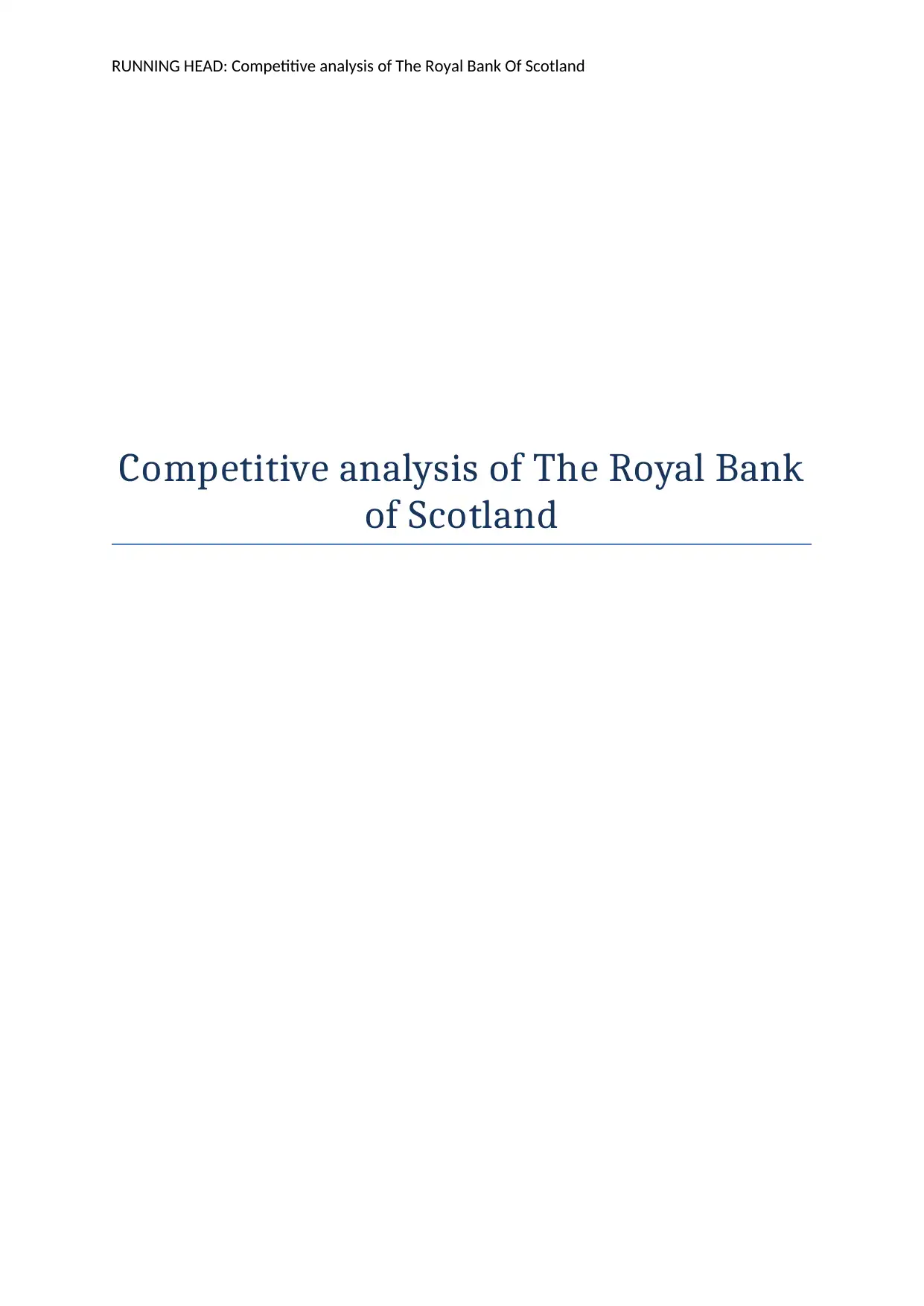
RUNNING HEAD: Competitive analysis of The Royal Bank Of Scotland
Competitive analysis of The Royal Bank
of Scotland
Competitive analysis of The Royal Bank
of Scotland
Paraphrase This Document
Need a fresh take? Get an instant paraphrase of this document with our AI Paraphraser
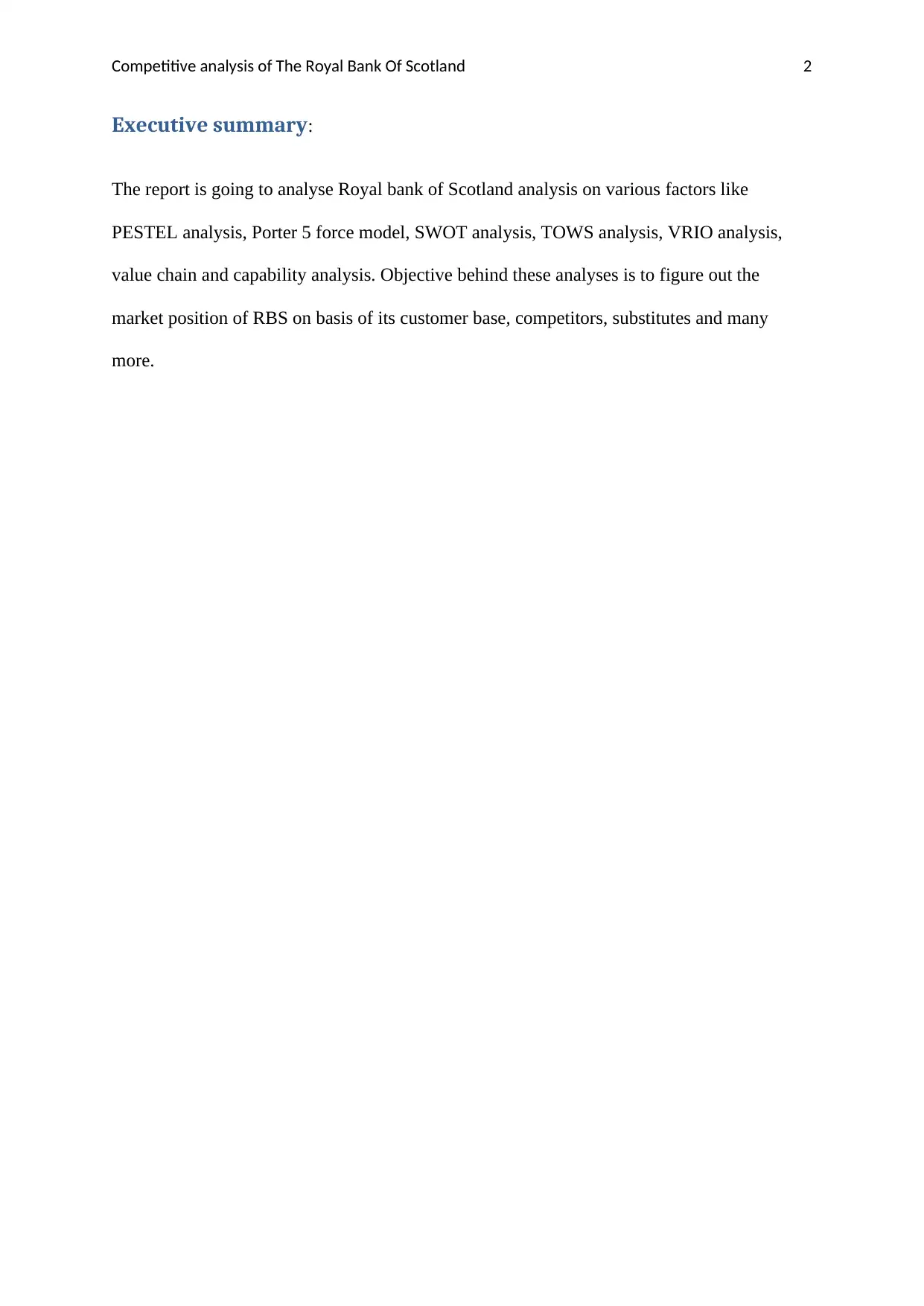
Competitive analysis of The Royal Bank Of Scotland 2
Executive summary:
The report is going to analyse Royal bank of Scotland analysis on various factors like
PESTEL analysis, Porter 5 force model, SWOT analysis, TOWS analysis, VRIO analysis,
value chain and capability analysis. Objective behind these analyses is to figure out the
market position of RBS on basis of its customer base, competitors, substitutes and many
more.
Executive summary:
The report is going to analyse Royal bank of Scotland analysis on various factors like
PESTEL analysis, Porter 5 force model, SWOT analysis, TOWS analysis, VRIO analysis,
value chain and capability analysis. Objective behind these analyses is to figure out the
market position of RBS on basis of its customer base, competitors, substitutes and many
more.
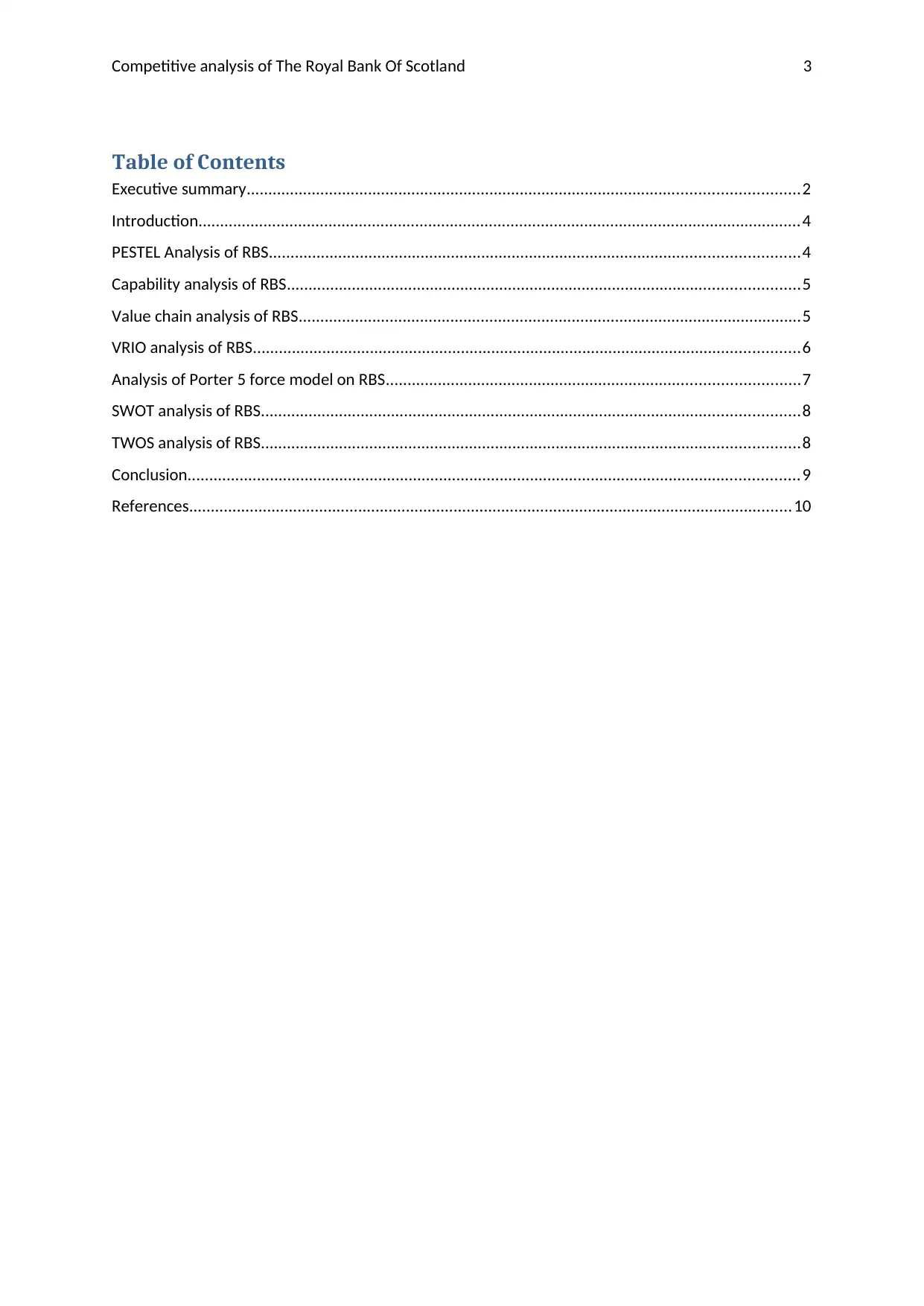
Competitive analysis of The Royal Bank Of Scotland 3
Table of Contents
Executive summary...............................................................................................................................2
Introduction...........................................................................................................................................4
PESTEL Analysis of RBS..........................................................................................................................4
Capability analysis of RBS......................................................................................................................5
Value chain analysis of RBS....................................................................................................................5
VRIO analysis of RBS..............................................................................................................................6
Analysis of Porter 5 force model on RBS...............................................................................................7
SWOT analysis of RBS............................................................................................................................8
TWOS analysis of RBS............................................................................................................................8
Conclusion.............................................................................................................................................9
References...........................................................................................................................................10
Table of Contents
Executive summary...............................................................................................................................2
Introduction...........................................................................................................................................4
PESTEL Analysis of RBS..........................................................................................................................4
Capability analysis of RBS......................................................................................................................5
Value chain analysis of RBS....................................................................................................................5
VRIO analysis of RBS..............................................................................................................................6
Analysis of Porter 5 force model on RBS...............................................................................................7
SWOT analysis of RBS............................................................................................................................8
TWOS analysis of RBS............................................................................................................................8
Conclusion.............................................................................................................................................9
References...........................................................................................................................................10
⊘ This is a preview!⊘
Do you want full access?
Subscribe today to unlock all pages.

Trusted by 1+ million students worldwide
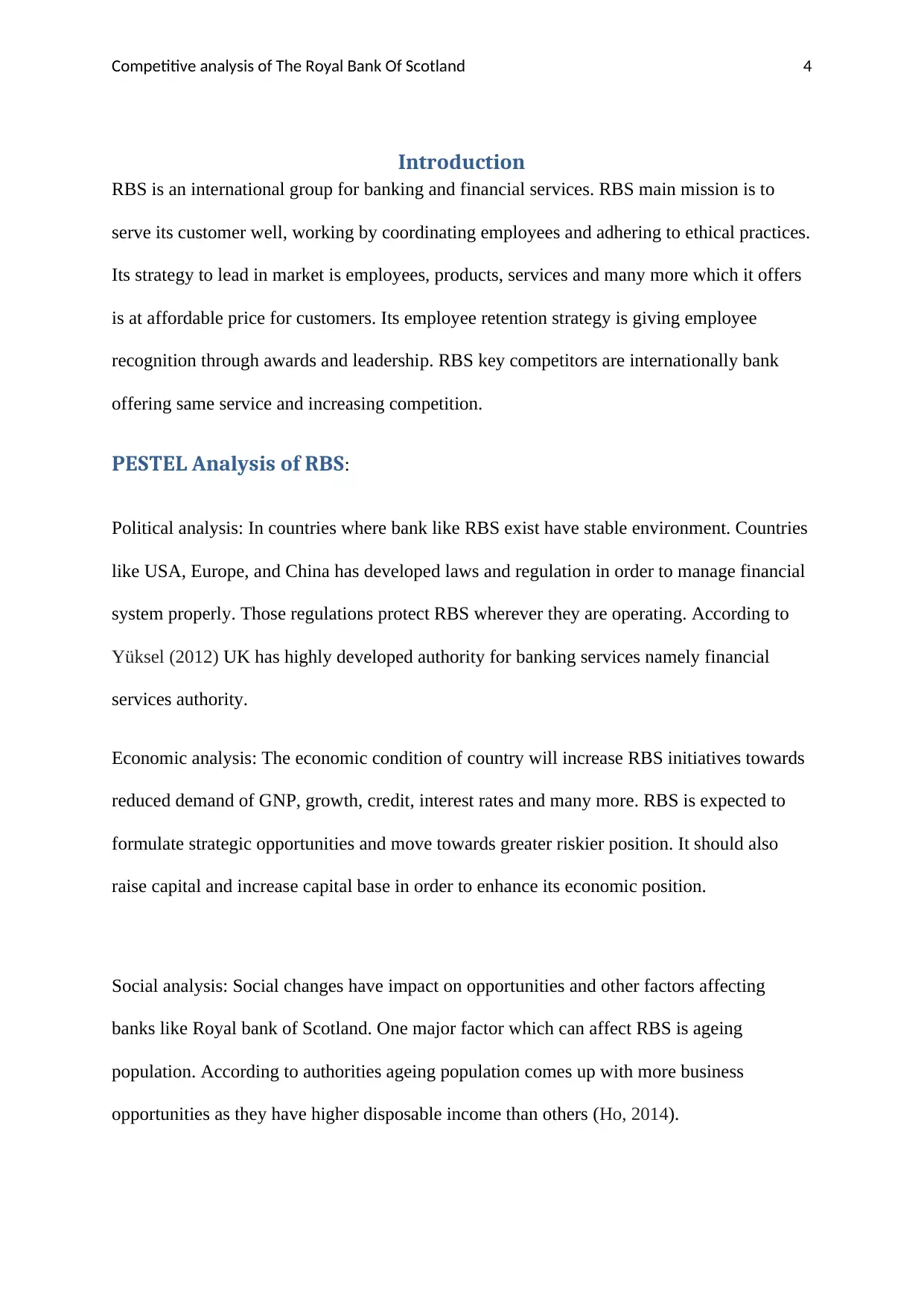
Competitive analysis of The Royal Bank Of Scotland 4
Introduction
RBS is an international group for banking and financial services. RBS main mission is to
serve its customer well, working by coordinating employees and adhering to ethical practices.
Its strategy to lead in market is employees, products, services and many more which it offers
is at affordable price for customers. Its employee retention strategy is giving employee
recognition through awards and leadership. RBS key competitors are internationally bank
offering same service and increasing competition.
PESTEL Analysis of RBS:
Political analysis: In countries where bank like RBS exist have stable environment. Countries
like USA, Europe, and China has developed laws and regulation in order to manage financial
system properly. Those regulations protect RBS wherever they are operating. According to
Yüksel (2012) UK has highly developed authority for banking services namely financial
services authority.
Economic analysis: The economic condition of country will increase RBS initiatives towards
reduced demand of GNP, growth, credit, interest rates and many more. RBS is expected to
formulate strategic opportunities and move towards greater riskier position. It should also
raise capital and increase capital base in order to enhance its economic position.
Social analysis: Social changes have impact on opportunities and other factors affecting
banks like Royal bank of Scotland. One major factor which can affect RBS is ageing
population. According to authorities ageing population comes up with more business
opportunities as they have higher disposable income than others (Ho, 2014).
Introduction
RBS is an international group for banking and financial services. RBS main mission is to
serve its customer well, working by coordinating employees and adhering to ethical practices.
Its strategy to lead in market is employees, products, services and many more which it offers
is at affordable price for customers. Its employee retention strategy is giving employee
recognition through awards and leadership. RBS key competitors are internationally bank
offering same service and increasing competition.
PESTEL Analysis of RBS:
Political analysis: In countries where bank like RBS exist have stable environment. Countries
like USA, Europe, and China has developed laws and regulation in order to manage financial
system properly. Those regulations protect RBS wherever they are operating. According to
Yüksel (2012) UK has highly developed authority for banking services namely financial
services authority.
Economic analysis: The economic condition of country will increase RBS initiatives towards
reduced demand of GNP, growth, credit, interest rates and many more. RBS is expected to
formulate strategic opportunities and move towards greater riskier position. It should also
raise capital and increase capital base in order to enhance its economic position.
Social analysis: Social changes have impact on opportunities and other factors affecting
banks like Royal bank of Scotland. One major factor which can affect RBS is ageing
population. According to authorities ageing population comes up with more business
opportunities as they have higher disposable income than others (Ho, 2014).
Paraphrase This Document
Need a fresh take? Get an instant paraphrase of this document with our AI Paraphraser
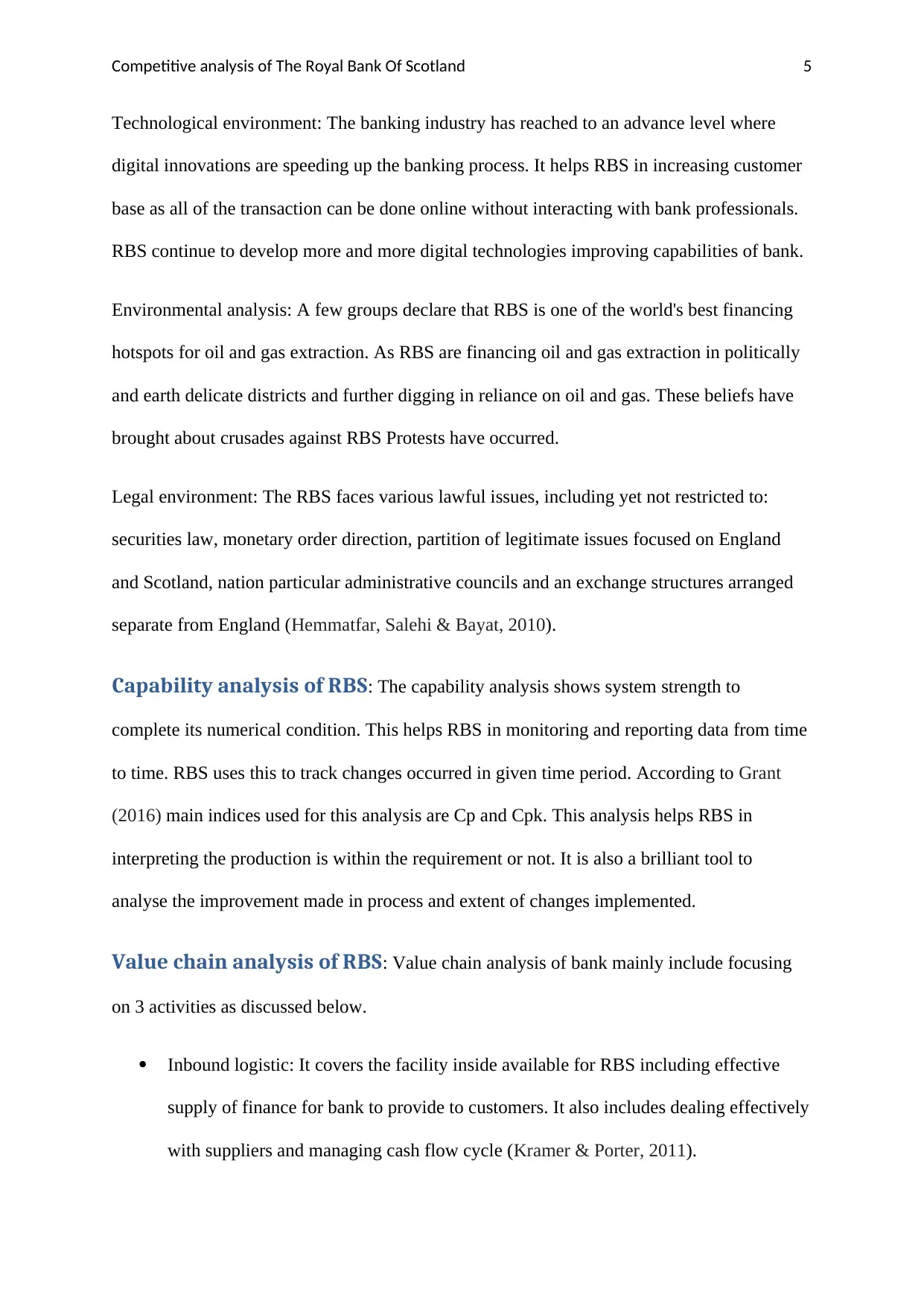
Competitive analysis of The Royal Bank Of Scotland 5
Technological environment: The banking industry has reached to an advance level where
digital innovations are speeding up the banking process. It helps RBS in increasing customer
base as all of the transaction can be done online without interacting with bank professionals.
RBS continue to develop more and more digital technologies improving capabilities of bank.
Environmental analysis: A few groups declare that RBS is one of the world's best financing
hotspots for oil and gas extraction. As RBS are financing oil and gas extraction in politically
and earth delicate districts and further digging in reliance on oil and gas. These beliefs have
brought about crusades against RBS Protests have occurred.
Legal environment: The RBS faces various lawful issues, including yet not restricted to:
securities law, monetary order direction, partition of legitimate issues focused on England
and Scotland, nation particular administrative councils and an exchange structures arranged
separate from England (Hemmatfar, Salehi & Bayat, 2010).
Capability analysis of RBS: The capability analysis shows system strength to
complete its numerical condition. This helps RBS in monitoring and reporting data from time
to time. RBS uses this to track changes occurred in given time period. According to Grant
(2016) main indices used for this analysis are Cp and Cpk. This analysis helps RBS in
interpreting the production is within the requirement or not. It is also a brilliant tool to
analyse the improvement made in process and extent of changes implemented.
Value chain analysis of RBS: Value chain analysis of bank mainly include focusing
on 3 activities as discussed below.
Inbound logistic: It covers the facility inside available for RBS including effective
supply of finance for bank to provide to customers. It also includes dealing effectively
with suppliers and managing cash flow cycle (Kramer & Porter, 2011).
Technological environment: The banking industry has reached to an advance level where
digital innovations are speeding up the banking process. It helps RBS in increasing customer
base as all of the transaction can be done online without interacting with bank professionals.
RBS continue to develop more and more digital technologies improving capabilities of bank.
Environmental analysis: A few groups declare that RBS is one of the world's best financing
hotspots for oil and gas extraction. As RBS are financing oil and gas extraction in politically
and earth delicate districts and further digging in reliance on oil and gas. These beliefs have
brought about crusades against RBS Protests have occurred.
Legal environment: The RBS faces various lawful issues, including yet not restricted to:
securities law, monetary order direction, partition of legitimate issues focused on England
and Scotland, nation particular administrative councils and an exchange structures arranged
separate from England (Hemmatfar, Salehi & Bayat, 2010).
Capability analysis of RBS: The capability analysis shows system strength to
complete its numerical condition. This helps RBS in monitoring and reporting data from time
to time. RBS uses this to track changes occurred in given time period. According to Grant
(2016) main indices used for this analysis are Cp and Cpk. This analysis helps RBS in
interpreting the production is within the requirement or not. It is also a brilliant tool to
analyse the improvement made in process and extent of changes implemented.
Value chain analysis of RBS: Value chain analysis of bank mainly include focusing
on 3 activities as discussed below.
Inbound logistic: It covers the facility inside available for RBS including effective
supply of finance for bank to provide to customers. It also includes dealing effectively
with suppliers and managing cash flow cycle (Kramer & Porter, 2011).
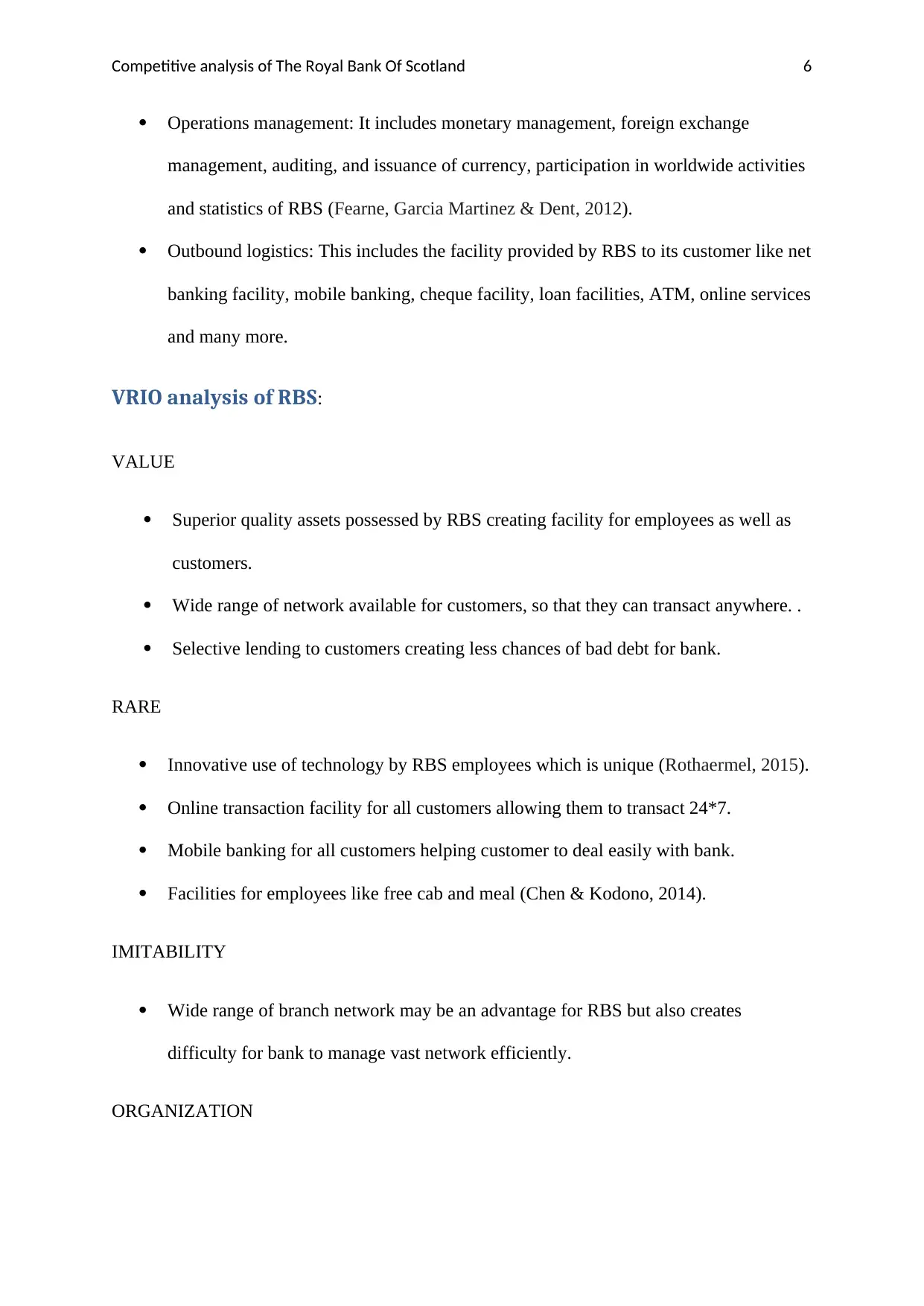
Competitive analysis of The Royal Bank Of Scotland 6
Operations management: It includes monetary management, foreign exchange
management, auditing, and issuance of currency, participation in worldwide activities
and statistics of RBS (Fearne, Garcia Martinez & Dent, 2012).
Outbound logistics: This includes the facility provided by RBS to its customer like net
banking facility, mobile banking, cheque facility, loan facilities, ATM, online services
and many more.
VRIO analysis of RBS:
VALUE
Superior quality assets possessed by RBS creating facility for employees as well as
customers.
Wide range of network available for customers, so that they can transact anywhere. .
Selective lending to customers creating less chances of bad debt for bank.
RARE
Innovative use of technology by RBS employees which is unique (Rothaermel, 2015).
Online transaction facility for all customers allowing them to transact 24*7.
Mobile banking for all customers helping customer to deal easily with bank.
Facilities for employees like free cab and meal (Chen & Kodono, 2014).
IMITABILITY
Wide range of branch network may be an advantage for RBS but also creates
difficulty for bank to manage vast network efficiently.
ORGANIZATION
Operations management: It includes monetary management, foreign exchange
management, auditing, and issuance of currency, participation in worldwide activities
and statistics of RBS (Fearne, Garcia Martinez & Dent, 2012).
Outbound logistics: This includes the facility provided by RBS to its customer like net
banking facility, mobile banking, cheque facility, loan facilities, ATM, online services
and many more.
VRIO analysis of RBS:
VALUE
Superior quality assets possessed by RBS creating facility for employees as well as
customers.
Wide range of network available for customers, so that they can transact anywhere. .
Selective lending to customers creating less chances of bad debt for bank.
RARE
Innovative use of technology by RBS employees which is unique (Rothaermel, 2015).
Online transaction facility for all customers allowing them to transact 24*7.
Mobile banking for all customers helping customer to deal easily with bank.
Facilities for employees like free cab and meal (Chen & Kodono, 2014).
IMITABILITY
Wide range of branch network may be an advantage for RBS but also creates
difficulty for bank to manage vast network efficiently.
ORGANIZATION
⊘ This is a preview!⊘
Do you want full access?
Subscribe today to unlock all pages.

Trusted by 1+ million students worldwide
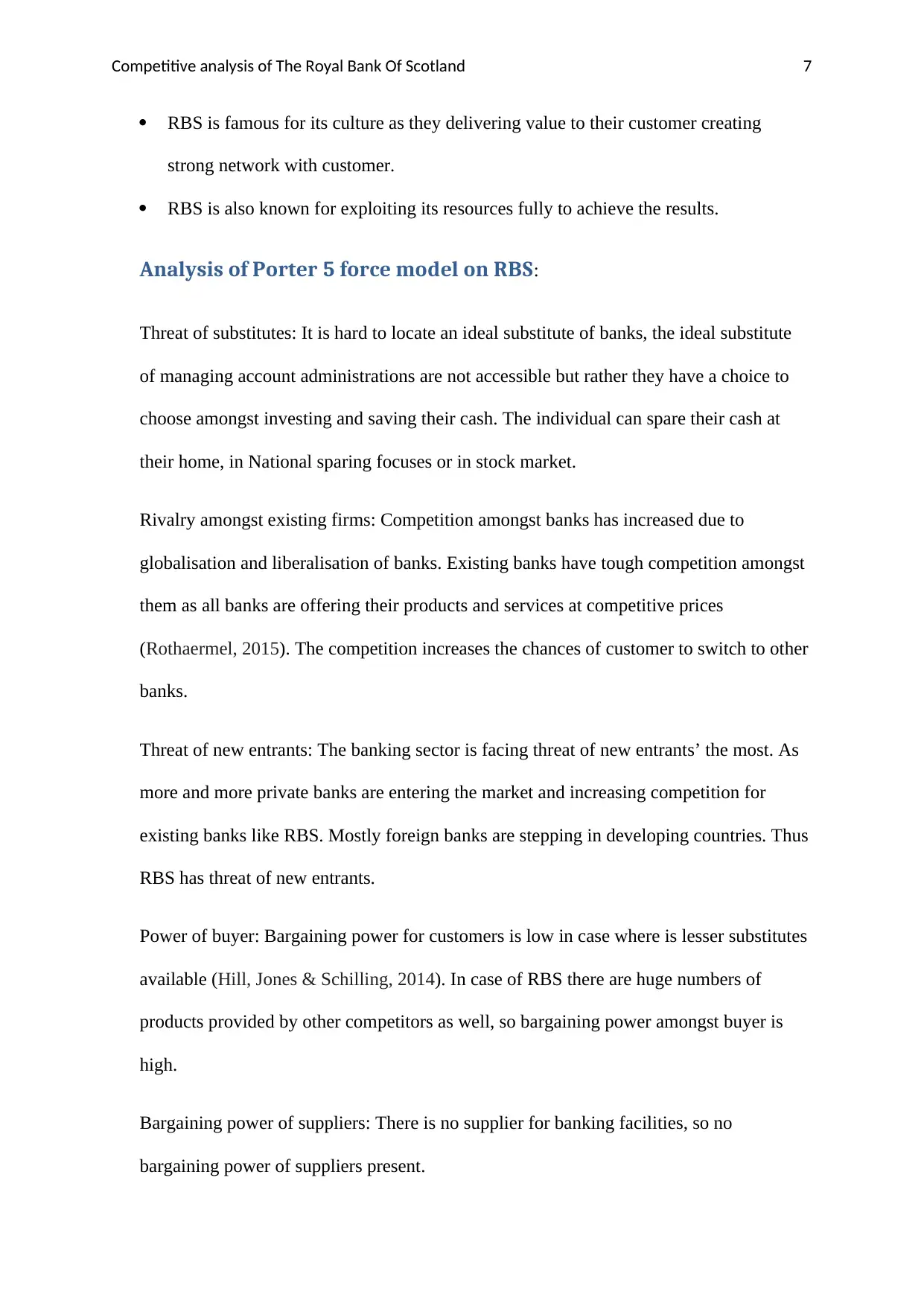
Competitive analysis of The Royal Bank Of Scotland 7
RBS is famous for its culture as they delivering value to their customer creating
strong network with customer.
RBS is also known for exploiting its resources fully to achieve the results.
Analysis of Porter 5 force model on RBS:
Threat of substitutes: It is hard to locate an ideal substitute of banks, the ideal substitute
of managing account administrations are not accessible but rather they have a choice to
choose amongst investing and saving their cash. The individual can spare their cash at
their home, in National sparing focuses or in stock market.
Rivalry amongst existing firms: Competition amongst banks has increased due to
globalisation and liberalisation of banks. Existing banks have tough competition amongst
them as all banks are offering their products and services at competitive prices
(Rothaermel, 2015). The competition increases the chances of customer to switch to other
banks.
Threat of new entrants: The banking sector is facing threat of new entrants’ the most. As
more and more private banks are entering the market and increasing competition for
existing banks like RBS. Mostly foreign banks are stepping in developing countries. Thus
RBS has threat of new entrants.
Power of buyer: Bargaining power for customers is low in case where is lesser substitutes
available (Hill, Jones & Schilling, 2014). In case of RBS there are huge numbers of
products provided by other competitors as well, so bargaining power amongst buyer is
high.
Bargaining power of suppliers: There is no supplier for banking facilities, so no
bargaining power of suppliers present.
RBS is famous for its culture as they delivering value to their customer creating
strong network with customer.
RBS is also known for exploiting its resources fully to achieve the results.
Analysis of Porter 5 force model on RBS:
Threat of substitutes: It is hard to locate an ideal substitute of banks, the ideal substitute
of managing account administrations are not accessible but rather they have a choice to
choose amongst investing and saving their cash. The individual can spare their cash at
their home, in National sparing focuses or in stock market.
Rivalry amongst existing firms: Competition amongst banks has increased due to
globalisation and liberalisation of banks. Existing banks have tough competition amongst
them as all banks are offering their products and services at competitive prices
(Rothaermel, 2015). The competition increases the chances of customer to switch to other
banks.
Threat of new entrants: The banking sector is facing threat of new entrants’ the most. As
more and more private banks are entering the market and increasing competition for
existing banks like RBS. Mostly foreign banks are stepping in developing countries. Thus
RBS has threat of new entrants.
Power of buyer: Bargaining power for customers is low in case where is lesser substitutes
available (Hill, Jones & Schilling, 2014). In case of RBS there are huge numbers of
products provided by other competitors as well, so bargaining power amongst buyer is
high.
Bargaining power of suppliers: There is no supplier for banking facilities, so no
bargaining power of suppliers present.
Paraphrase This Document
Need a fresh take? Get an instant paraphrase of this document with our AI Paraphraser
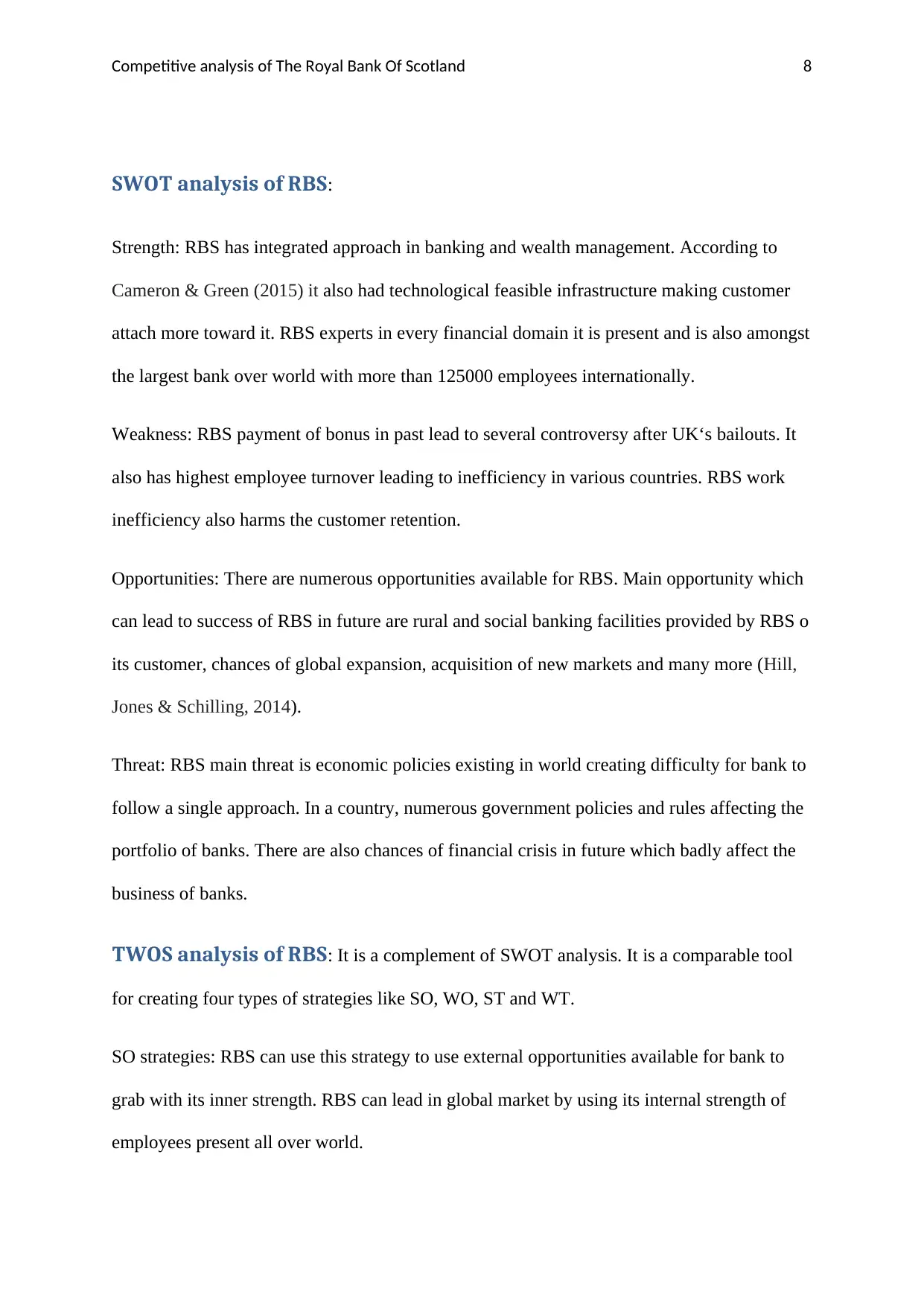
Competitive analysis of The Royal Bank Of Scotland 8
SWOT analysis of RBS:
Strength: RBS has integrated approach in banking and wealth management. According to
Cameron & Green (2015) it also had technological feasible infrastructure making customer
attach more toward it. RBS experts in every financial domain it is present and is also amongst
the largest bank over world with more than 125000 employees internationally.
Weakness: RBS payment of bonus in past lead to several controversy after UK‘s bailouts. It
also has highest employee turnover leading to inefficiency in various countries. RBS work
inefficiency also harms the customer retention.
Opportunities: There are numerous opportunities available for RBS. Main opportunity which
can lead to success of RBS in future are rural and social banking facilities provided by RBS o
its customer, chances of global expansion, acquisition of new markets and many more (Hill,
Jones & Schilling, 2014).
Threat: RBS main threat is economic policies existing in world creating difficulty for bank to
follow a single approach. In a country, numerous government policies and rules affecting the
portfolio of banks. There are also chances of financial crisis in future which badly affect the
business of banks.
TWOS analysis of RBS: It is a complement of SWOT analysis. It is a comparable tool
for creating four types of strategies like SO, WO, ST and WT.
SO strategies: RBS can use this strategy to use external opportunities available for bank to
grab with its inner strength. RBS can lead in global market by using its internal strength of
employees present all over world.
SWOT analysis of RBS:
Strength: RBS has integrated approach in banking and wealth management. According to
Cameron & Green (2015) it also had technological feasible infrastructure making customer
attach more toward it. RBS experts in every financial domain it is present and is also amongst
the largest bank over world with more than 125000 employees internationally.
Weakness: RBS payment of bonus in past lead to several controversy after UK‘s bailouts. It
also has highest employee turnover leading to inefficiency in various countries. RBS work
inefficiency also harms the customer retention.
Opportunities: There are numerous opportunities available for RBS. Main opportunity which
can lead to success of RBS in future are rural and social banking facilities provided by RBS o
its customer, chances of global expansion, acquisition of new markets and many more (Hill,
Jones & Schilling, 2014).
Threat: RBS main threat is economic policies existing in world creating difficulty for bank to
follow a single approach. In a country, numerous government policies and rules affecting the
portfolio of banks. There are also chances of financial crisis in future which badly affect the
business of banks.
TWOS analysis of RBS: It is a complement of SWOT analysis. It is a comparable tool
for creating four types of strategies like SO, WO, ST and WT.
SO strategies: RBS can use this strategy to use external opportunities available for bank to
grab with its inner strength. RBS can lead in global market by using its internal strength of
employees present all over world.
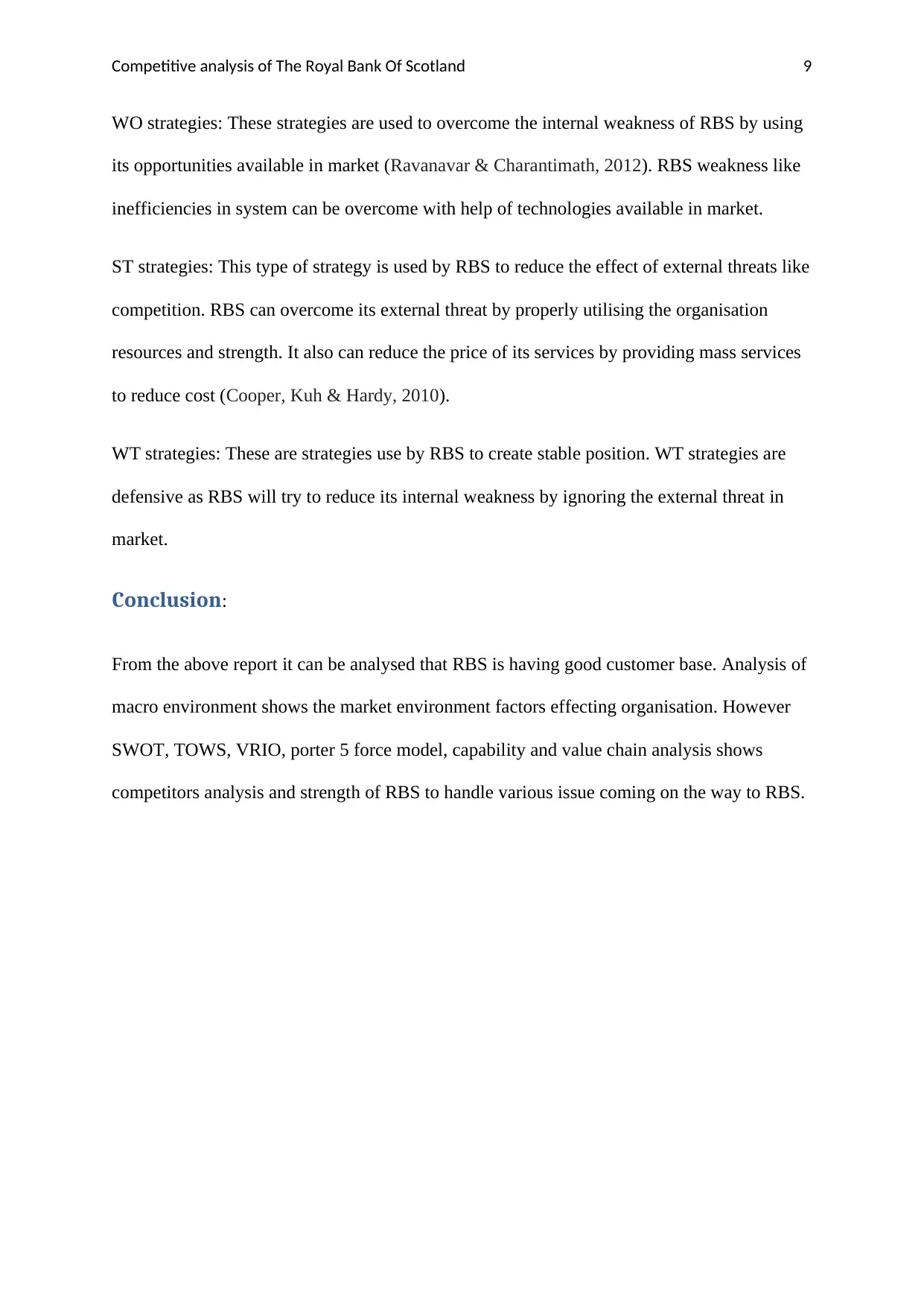
Competitive analysis of The Royal Bank Of Scotland 9
WO strategies: These strategies are used to overcome the internal weakness of RBS by using
its opportunities available in market (Ravanavar & Charantimath, 2012). RBS weakness like
inefficiencies in system can be overcome with help of technologies available in market.
ST strategies: This type of strategy is used by RBS to reduce the effect of external threats like
competition. RBS can overcome its external threat by properly utilising the organisation
resources and strength. It also can reduce the price of its services by providing mass services
to reduce cost (Cooper, Kuh & Hardy, 2010).
WT strategies: These are strategies use by RBS to create stable position. WT strategies are
defensive as RBS will try to reduce its internal weakness by ignoring the external threat in
market.
Conclusion:
From the above report it can be analysed that RBS is having good customer base. Analysis of
macro environment shows the market environment factors effecting organisation. However
SWOT, TOWS, VRIO, porter 5 force model, capability and value chain analysis shows
competitors analysis and strength of RBS to handle various issue coming on the way to RBS.
WO strategies: These strategies are used to overcome the internal weakness of RBS by using
its opportunities available in market (Ravanavar & Charantimath, 2012). RBS weakness like
inefficiencies in system can be overcome with help of technologies available in market.
ST strategies: This type of strategy is used by RBS to reduce the effect of external threats like
competition. RBS can overcome its external threat by properly utilising the organisation
resources and strength. It also can reduce the price of its services by providing mass services
to reduce cost (Cooper, Kuh & Hardy, 2010).
WT strategies: These are strategies use by RBS to create stable position. WT strategies are
defensive as RBS will try to reduce its internal weakness by ignoring the external threat in
market.
Conclusion:
From the above report it can be analysed that RBS is having good customer base. Analysis of
macro environment shows the market environment factors effecting organisation. However
SWOT, TOWS, VRIO, porter 5 force model, capability and value chain analysis shows
competitors analysis and strength of RBS to handle various issue coming on the way to RBS.
⊘ This is a preview!⊘
Do you want full access?
Subscribe today to unlock all pages.

Trusted by 1+ million students worldwide
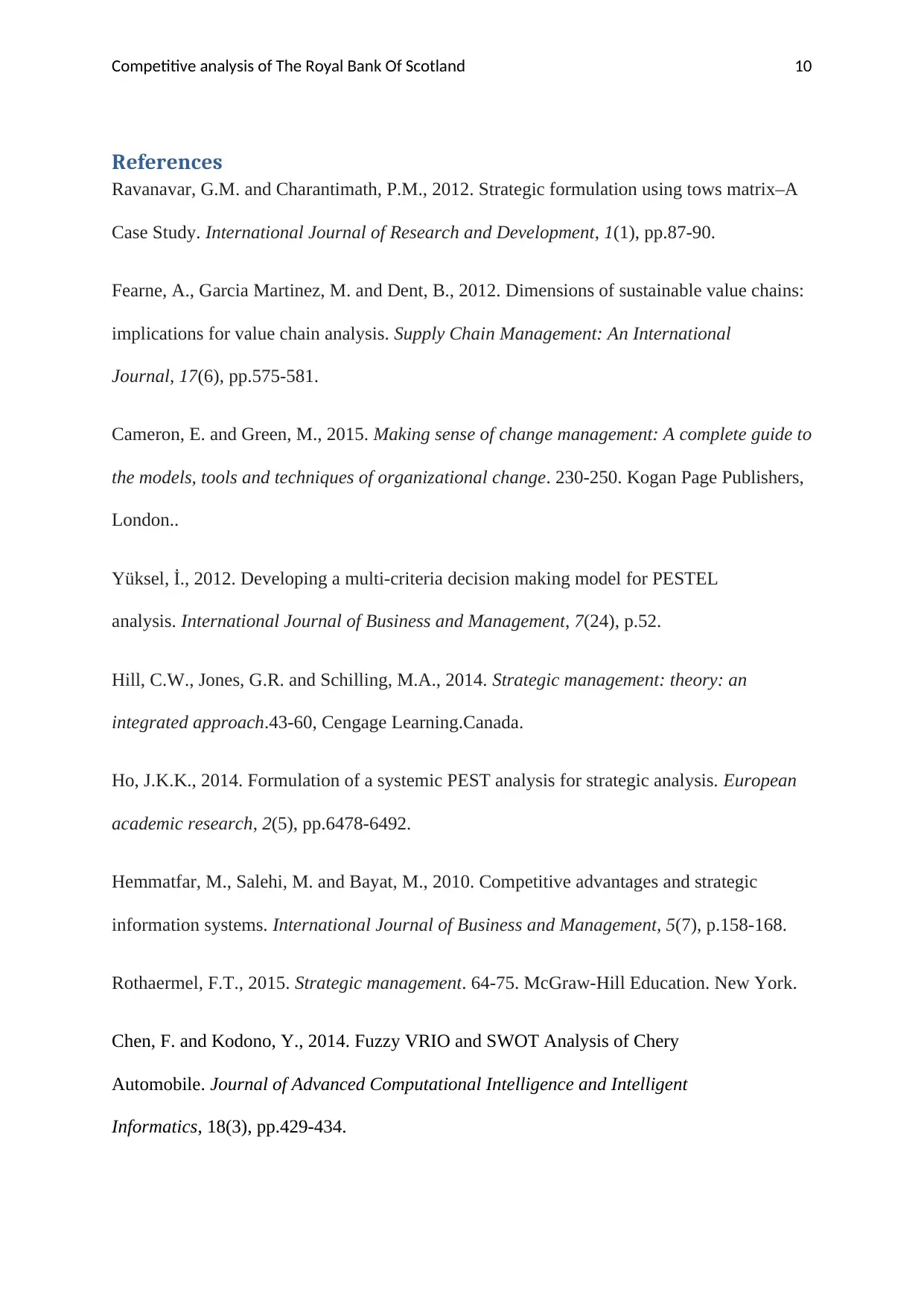
Competitive analysis of The Royal Bank Of Scotland 10
References
Ravanavar, G.M. and Charantimath, P.M., 2012. Strategic formulation using tows matrix–A
Case Study. International Journal of Research and Development, 1(1), pp.87-90.
Fearne, A., Garcia Martinez, M. and Dent, B., 2012. Dimensions of sustainable value chains:
implications for value chain analysis. Supply Chain Management: An International
Journal, 17(6), pp.575-581.
Cameron, E. and Green, M., 2015. Making sense of change management: A complete guide to
the models, tools and techniques of organizational change. 230-250. Kogan Page Publishers,
London..
Yüksel, İ., 2012. Developing a multi-criteria decision making model for PESTEL
analysis. International Journal of Business and Management, 7(24), p.52.
Hill, C.W., Jones, G.R. and Schilling, M.A., 2014. Strategic management: theory: an
integrated approach.43-60, Cengage Learning.Canada.
Ho, J.K.K., 2014. Formulation of a systemic PEST analysis for strategic analysis. European
academic research, 2(5), pp.6478-6492.
Hemmatfar, M., Salehi, M. and Bayat, M., 2010. Competitive advantages and strategic
information systems. International Journal of Business and Management, 5(7), p.158-168.
Rothaermel, F.T., 2015. Strategic management. 64-75. McGraw-Hill Education. New York.
Chen, F. and Kodono, Y., 2014. Fuzzy VRIO and SWOT Analysis of Chery
Automobile. Journal of Advanced Computational Intelligence and Intelligent
Informatics, 18(3), pp.429-434.
References
Ravanavar, G.M. and Charantimath, P.M., 2012. Strategic formulation using tows matrix–A
Case Study. International Journal of Research and Development, 1(1), pp.87-90.
Fearne, A., Garcia Martinez, M. and Dent, B., 2012. Dimensions of sustainable value chains:
implications for value chain analysis. Supply Chain Management: An International
Journal, 17(6), pp.575-581.
Cameron, E. and Green, M., 2015. Making sense of change management: A complete guide to
the models, tools and techniques of organizational change. 230-250. Kogan Page Publishers,
London..
Yüksel, İ., 2012. Developing a multi-criteria decision making model for PESTEL
analysis. International Journal of Business and Management, 7(24), p.52.
Hill, C.W., Jones, G.R. and Schilling, M.A., 2014. Strategic management: theory: an
integrated approach.43-60, Cengage Learning.Canada.
Ho, J.K.K., 2014. Formulation of a systemic PEST analysis for strategic analysis. European
academic research, 2(5), pp.6478-6492.
Hemmatfar, M., Salehi, M. and Bayat, M., 2010. Competitive advantages and strategic
information systems. International Journal of Business and Management, 5(7), p.158-168.
Rothaermel, F.T., 2015. Strategic management. 64-75. McGraw-Hill Education. New York.
Chen, F. and Kodono, Y., 2014. Fuzzy VRIO and SWOT Analysis of Chery
Automobile. Journal of Advanced Computational Intelligence and Intelligent
Informatics, 18(3), pp.429-434.
Paraphrase This Document
Need a fresh take? Get an instant paraphrase of this document with our AI Paraphraser
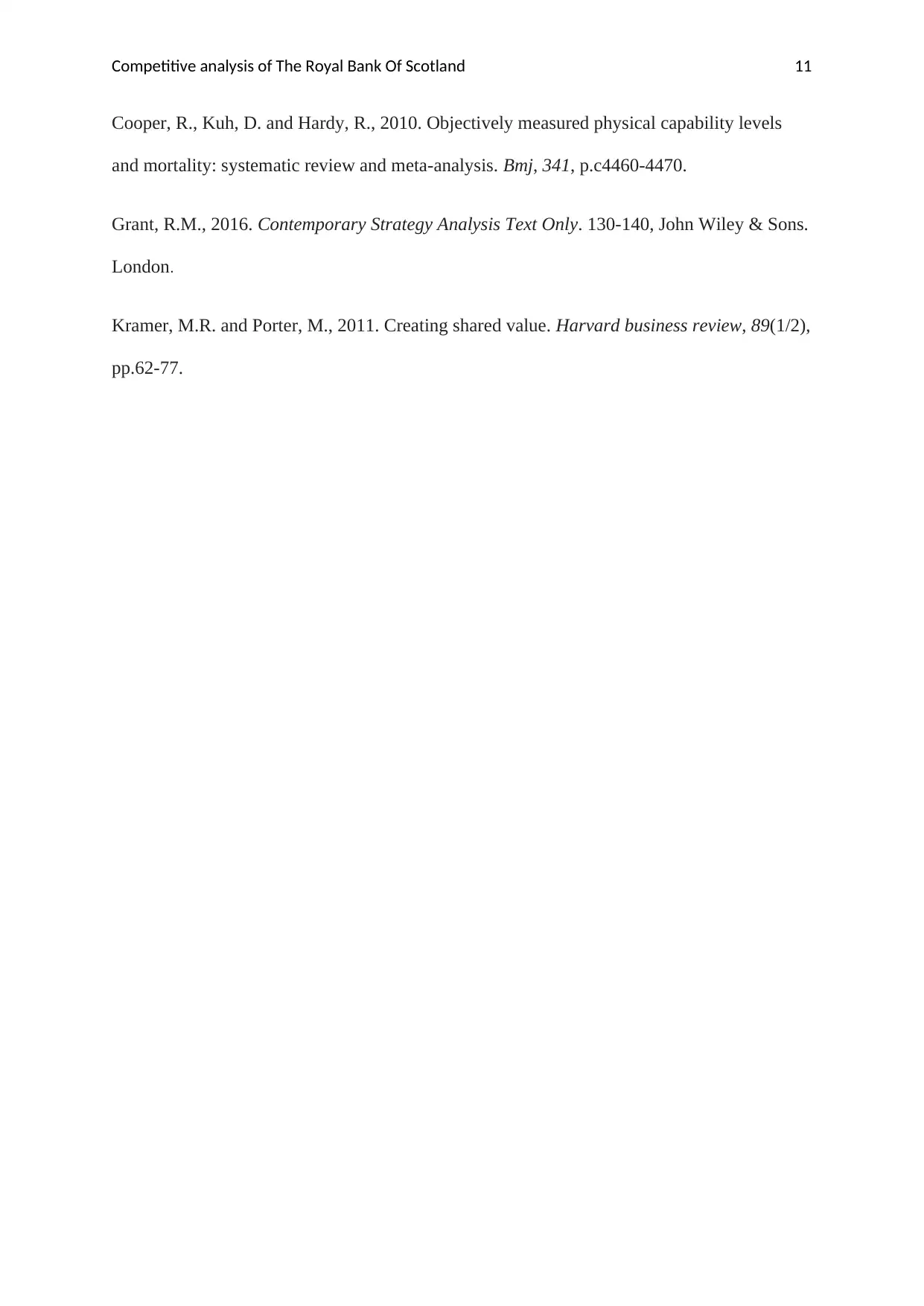
Competitive analysis of The Royal Bank Of Scotland 11
Cooper, R., Kuh, D. and Hardy, R., 2010. Objectively measured physical capability levels
and mortality: systematic review and meta-analysis. Bmj, 341, p.c4460-4470.
Grant, R.M., 2016. Contemporary Strategy Analysis Text Only. 130-140, John Wiley & Sons.
London.
Kramer, M.R. and Porter, M., 2011. Creating shared value. Harvard business review, 89(1/2),
pp.62-77.
Cooper, R., Kuh, D. and Hardy, R., 2010. Objectively measured physical capability levels
and mortality: systematic review and meta-analysis. Bmj, 341, p.c4460-4470.
Grant, R.M., 2016. Contemporary Strategy Analysis Text Only. 130-140, John Wiley & Sons.
London.
Kramer, M.R. and Porter, M., 2011. Creating shared value. Harvard business review, 89(1/2),
pp.62-77.
1 out of 11
Related Documents
Your All-in-One AI-Powered Toolkit for Academic Success.
+13062052269
info@desklib.com
Available 24*7 on WhatsApp / Email
![[object Object]](/_next/static/media/star-bottom.7253800d.svg)
Unlock your academic potential
Copyright © 2020–2025 A2Z Services. All Rights Reserved. Developed and managed by ZUCOL.





